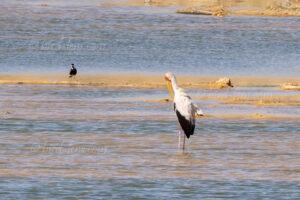 The aim of a trip in April 2023 was to visit Egypt again after a long time. On the one hand to round off the list of birds in the western Palaearctic and on the other hand to observe the bird migration along the Nile. During our previous stays we had mostly been to the Red Sea. A detailed trip report of the journey in April 2023 to Aswan & Abu Simbel is available here!
The aim of a trip in April 2023 was to visit Egypt again after a long time. On the one hand to round off the list of birds in the western Palaearctic and on the other hand to observe the bird migration along the Nile. During our previous stays we had mostly been to the Red Sea. A detailed trip report of the journey in April 2023 to Aswan & Abu Simbel is available here!
A triplist of 96 species after 2 weeks is of course nothing to what you might normally used to.
Overall, the bird migration along the Nile did not meet my expectations. Compared to the trip to the Red Sea in May 2005 with its 119 species, I even saw 23 species fewer. Besides the masses of Swallows (especially Barn Swallow and Sand Martins), the good migration of European Bee-eaters (Merops apiaster), only the surprising number of Wood Warblers (Phylloscopus sibilatrix) can be attributed to good migration.
On the contrast, migration of the Yellow Wagtail (Motacilla flava) was pretty meager. And one Spotted Flycatcher (Muscicapa striata), one Common Redstart (Phoenicurus phoenicurus), two Whinchats (Saxicola rubetra) and one Northern Wheatear (Oenanthe oenanthe) are not exactly something you would expect from hotspots in a migration corridor.
For spotting desert birds in the western Palearctic, there are arguably better countries than Egypt. Apparently access to the desert is restrictive after all; not as restrictive as in the Red Sea area. But not easy either. The Thoska Chanal in the New Valley Governorate certainly has potential. Apparently, however, access is very restrictively handled by the military.
To round off the Western Palaearctic list, southern Egypt is described a must. With the Yellow-billed Stork (Mycteria ibis), the Brown-throated Sand martin or the Plain Martin (Riparia paludicola) and the Great White Pelican (Pelecanus onocrotalus) I was reasonably successful, too. On the other hand, African species such as Mourning Collared Dove (Streptopelia decipiens), Three-banded Plover (Charadrius tricollaris) African Skimmer (Rynchops flavirostris) are mentioned as possibilities for southern Egypt as well.
According to eBird, however, the last sighting of the Mourning Collared Dove dates back from the beginning of August 2013 from Abu Simbel, Aswan. The last observation – apart from a rather questionable report from 23 Jun 2022 from the Pyramids of Giza – of the African Skimmer also dates back from the beginning of August 2013.
Only the Three-banded Plover, the last report of which came from a very reliable ornithologist, Ismael Khalifa, on March 20, 2023, should continue to be considered a reasonably possible Africa specialty. However, during 3 visits to the Amun Tot Fish Ponds we could not spot this Plover.
The above does not apply to the Pharaoh Eagle-Owl (Bubo ascalaphus). Its range extends regularly to the south of the western Palaearctic. Its – supposedly reliable – long-standing occurrence at the Abu Simbel Temple seems to have been abandoned in the meantime. Only the Eurasian Kestrel (Falco tinnunculus) could be found there.
The fact that there aren’t that many trip reports for southern Egypt on CloudBirder is maybe no coincidence. It should give a future birder food for thought.
But of course: the quality of the species in general on this trip is impressive. Of course, the many good images of the Egyptian Nightjar (Caprimulgus aegyptius) and the observations of White-throated Munia or Indian Silverbill (Lonchura malabarica) and the Plain Martin (Riparia paludicola) are really remarkable. But both are still not certified by eBird although both were delivered with photos and now it is 4 weeks after the entry.
On the other hand, there are „strange“ species such as the Pomarine Jaeger (Stercorarius pomarinus) from April 28, 2023 from Abu Simbel Temple. More careful support from eBird would certainly be helpful. This applies in particular to a total of 65(!) reports from an observer on May 4th, which contain many, many “specialties”. All are given with a sighting of one specimen; in the abundance and composition of the list of species, these observations are not only questionable, but implausible. Whether the report of the Nubian Nightjar (Caprimulgus nubicus) – allegedly from February 15, 2016 from Aswan High Dam, is realistic, or simply a misidentification – possibly with a “normal” Nightjar (Caprimulgus europaeus) on migration, also cannot be checked.
For the photography of White-winged Terns (Chlidonias leucopterus), Senegal Thick-knees (Burhinus senegalensis) and Ferruginous Ducks (Aythya nyroca) there are probably not that easy to find alternatives in the western Palaearctic.
To cope with the growing demand for top shots of the rarer species of the Palearctic Bird-Lens is keen to enrich the range of pictures of birds you can find in the western palearctic. Trips to remote places like this one to capture images not only of rare birds of western palearctic were very successful. The nice image of the blog is only a first impression, what you will find in the gallery in the “Picture Shop” very soon. Just give bird-lens.com a message, if bird-lens.com could serve you with an image needed before the new pictures are online.